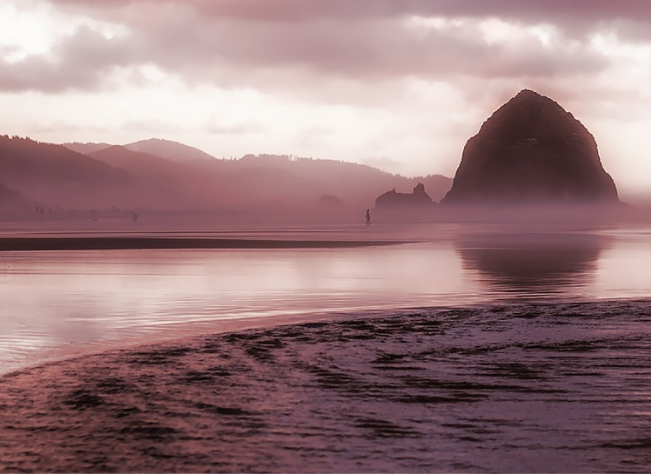
Today, Oregon's Coordinating Council on Ocean Acidification and Hypoxia (OAH) met for the second time this year to further develop recommendations for the state to take action locally on these climate-driven ocean issues affecting our nearshore ocean. Both Hypoxia, or low oxygen water, and Ocean Acidification, low pH or more "acidic" water, can have major impacts on ocean ecosystems and the industries that depend on a healthy ocean environment. Oregon first realized the threats of ocean acidification when Oregon oyster hatchery production collapsed in 2007. Since then, Oregon has been a leader in advancing science and monitoring; however, Washington and California have both moved past Oregon in advancing mitigation and restoration steps to curb OAH impacts and invest in resilient ecosystems. So what's Oregon's next move?
Superhero Scientists and Monitoring
Maybe I'm biased, but Oregon certainly has what I would call some the most respected and top tier scientists monitoring oceanographic conditions for OAH. Oregon State University's Burke Hales, Francis Chan, Jack Barth and George Waldbusser (to name a few) read like Marvel characters avenging the threats of climate change with superhero science. They wield weapons like the "Burkelator" for monitoring water chemistry and compounds critical for shell formation in critters like oysters and mussels, threatened by OAH. They form allies and extended partnerships for monitoring and awareness with citizen scientists groups like our very own Surfrider Chapters, The Nature Conservancy, and Marine Reserve Community groups and other NGOs. But despite all this amazing superhero science, monitoring and community collaborations, Oregon falls a bit behind Washington and California when it comes to activating management actions on the ground to combat OAH.
In Comes SB 1039 (2017 Legislative Session)
Senate Bill 1039, legislation spearheaded by Senator Arnie Roblan, passed during the 2017 Oregon Legislative session and was developed to address these arising ocean issues that Oregon had well documented now with 10 years of superhero monitoring and near shellfish industry collapse. The bill created the Coordinating Council on Ocean Acidification and Hypoxia in order to: make recommendations to the State on actions to take to better understand OAH, to mitigate the impacts of OAH, and to help Oregon adapt to an uncertain future of change. Recognizing the dependence of Oregonians on a healthy ocean environment for fisheries, tourism and recreation, the legislation put a tight deadline on the Council to make recommendations to the legislature by September of 2018.
Go Time for the Council
So the heat is on and waters' acidic for the OAH Council to thread the needle of politics, science and recommended actions in the next 6 months and if you want to keep up with them, you can track the public meetings and process here. The Council has two neighboring states that are already advancing on a variety of mitigation actions such as kelp and seagrass restoration with a "no regrets" approach to investing in resilient ecosystems that can potentially dampen the impacts of ocean acidification and hypoxia. Localized actions such as these projects can provide for resiliency of plants and animals to cope with changing ocean conditions...and the humans that depend on them. Lucky for Oregon's OAH Council, we have some awesome recommendations and lessons learned from these states and their projects, so it's just a matter of getting our ducks in a row between now and September.
Let's Not Reinvent the Wheel
Yes we're different in Oregon, we're special and we do things the Oregon way which takes a little longer sometimes, but we need not completely reinvent the wheel on this work. Advancing on our state's fantastic science and monitoring, outreach, community/industry engagement and top resource management, it's time to take the next step in investing in our coastal ecosystems resiliency and ability to adapt to these changing ocean conditions. Surfrider Foundation played a key role in advancing leadership in Washington and California, so below we offer the following resources for our stakeholders in Oregon to consider as the Council begins crafting recommended actions:
Washington's Blue Ribbon Recommendations & 2017 Addendum
Ocean Acidification Policy Lessons: WA Journal of Environmental Law and Policy
CA Ocean Protection Council: Ocean Acidification and Hypoxia Reduction Program
Seagrass and Kelp as Ocean Acidification Management Tool
 Ocean Friendly Gardens, such as this one at a PDX school, helps prevent polluted runoff and improves water quality, potentially reducing the impacts of OAH
Ocean Friendly Gardens, such as this one at a PDX school, helps prevent polluted runoff and improves water quality, potentially reducing the impacts of OAH
Think Global Act Local!
The first step is to educate yourself! Surfrider has developed an awesome Story Map to better engage audiences in understanding OAH issues and the individuals on the ground supporting monitoring and policy efforts! This awesome website is constantly being updated with new videos, community stories and real scientific monitoring data, so check it out! Ocean Acidification is directly connected to the amount of CO2 in our atmosphere, so reducing your greenhouse gases and dependence on fossil fuels is one awesome way you can be part of the broader solution. Because OAH can be exacerbated by polluted water and runoff, taking water quality steps such as planting an Ocean Friendly Garden and reducing polluted runoff in the urban landscape can have scaleable impacts - especially in the urban/inland environment where your actions can have huge implications on our ocean 10os of miles away! Hop on over to Ridgetops to Rooftops to Reefs to learn more about how different Surfrider programs and initiatives can allow you to act locally on this globally challenging issue with our oceans!



